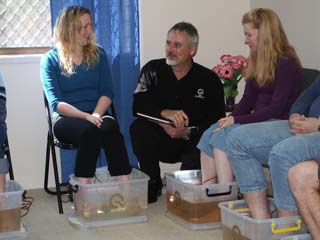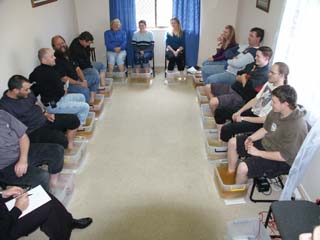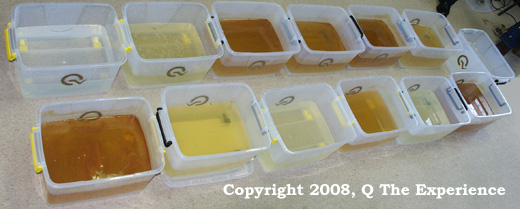Water Colors, Dirt, and Smells
Table of Contents
Water colors seem to be a common subject with footbaths. The coloration and precipitation of the water colors after every session is primarily due to the following. A combination of the degradation of the rings within the Orb (water module) and the impurities present in the water source. However, if these were the only two factors affecting coloration and these factors remained constant, one would expect the same coloration outcomes after every session. This is not the case. Several other factors also play a role.
The main factors that affect water colors are:
- Water Source
- Conductive Agent
- The person in the session
- The temperature of the water
- Weather and other Environmental Factors
- Orb
- Power Supply
- Container used
- Please Note: A session without any person in it may also cause discoloration and precipitation in the water.
In the industrialized world of today, “living” energetically charged water is a rarity. In our drinking water supply systems, water is exposed to the detrimental energetic effects of straight unnatural water pipes, high main pressures, and chemical treatments. Water is not allowed to move in its naturally winding way thereby causing loss of life force. Negative energetic imprints from chemicals, such as fertilizers, pesticides, and sterilizers remain in the water, even after the physical removal of such substances. (Dr. Wolfgang Ludwig & Prof. Jacques Benveniste)
Factors affecting water colors.
1. Water Source:
Under ideal water conditions, no discoloration and precipitation occur. Note that water sources are ever-changing. For example, the conductivity and atmospheric electrical activity alter during certain times of the year and may fluctuate during periods of rain.
Tap water (treated) – Generally has good conductivity and is readily available. Discoloration and precipitation depend on the treatment by your local water treatment plant and other local environmental factors.
Well or groundwater – Generally very conductive, may require diluting by adding either tank or distilled water. Different sources of bore water affect the colors and precipitation differently. Environmental factors play a large role.
Tank or distilled water – Generally very little conductivity. Often requires a small amount of ‘Conductive Agent’ for the unit to operate (the only instance that anything should be added to the water).
During the session, some of the minerals, chemicals, and other impurities suspended in the water, along with the degradation of the rings, congeal to form large molecules, evident in more precipitation and discoloration.
2. Conductive agent (salt):
Under normal circumstances, no ‘Conductive Agent’ is required for the QEnergySpa to operate. In the rare event that the conductivity of the water is too low, a ‘Conductive Agent’ may be added. Adding ‘Conductive Agent’ results in increased precipitation and coloration. Rock salt or sea salt are the only two current ‘Conductive Agents’ we recommend. At the rate of ¼ – ½ teaspoon per 3 gallons of water (1g per gallon).
Please note: NEVER use Himalayan Pink Salt.
Most pink Himalayan salt actually comes from a Pakistani government-owned mine that’s south of the famed mountains. The Khewra Salt Mine is now a tourist attraction, but its history is violent. During British colonial rule, the British forced locals to work in slave-like conditions in the mine. Even today, wages are low. Pakistani newspaper The Dawn reported in 2018 that a miner makes 350 Pakistani rupees, or about $2.50, for every ton of salt excavated.
 3. Person in session:
3. Person in session:
We all have unique bio-energy fields or signatures (which are constantly changing due to various exposures) much like fingerprints. Even identical twins with seemingly the same health status have different bio-energetic fields. These different bio-energy fields interact differently with the water, resulting in diverse colors and solids.
One of the most common misconceptions is that people using these devices are detoxifying through the soles of their feet and that the resulting color is a direct clinical interpretation indicative of specific ailments. This is a medical ‘Detox hoax’. No interpretation or diagnosis should ever be applied to any color and or precipitation. A visual inspection of the water in the first few minutes during the session will clearly show the precipitation arising from the ORB and NOT from around your feet.
 Detoxification takes place through the body’s natural channels and is but one aspect of regaining better health.
Detoxification takes place through the body’s natural channels and is but one aspect of regaining better health.
The QEnergySpa is capable of much more. A test of 13 people was conducted using the same water on the same day resulting in different colors and sediments. The lightest water colors (top left of picture) came from the heaviest smoker in the room, clearly showing that no interpretation can be applied to the water colors and the toxins are not drawn out of the soles of the feet.
4. Temperature of the water:
Changing the temperature changes the conductivity of the water. It also affects the lattice structure of the water. The temperature of the water helps determine the release rate of toxins from the water. Hot water will release solids at a faster rate than cold water, provided there are materials in the water that can be released. Even though heating the water damages the lattice structure, the critical temperature for the ‘damage’ to occur is 87.1 degrees Celsius, which is well inside the critical temperature for sessions. That said, please use the water temperature that suits you to leave your feet in for 35 minutes. Personally, I prefer hot water.
As a result of the vast misinformation from competitive products in the marketplace regarding water colors and detoxification, Q the Experience experimented with an earlier model power supply and Array to demonstrate the differences that can be achieved by changing water temperature. Two trials were conducted using 33 and 45 degrees Celsius water. In this experiment water temperature was the only variable, all other factors remained constant. Note: this water was treated by itself, no human contact was made during the session.
reticulated tap water temperatures at 33ºC. | reticulated tap water temperatures at 45ºC. | |
|---|---|---|
|
| |
| Picture 1a: Before the beginning. Note the number of lights on the power supply in the background. | Picture 1b: Before the beginning. | |
 |  | |
| Picture 2a: After 10 Minutes | Picture 2b: After 10 Minutes Notice that the color and the amount of sedimentation are already more than that shown in the Picture 2a. | |
 |
| |
| Picture 3a: After 20 Minutes | Picture 3b: After 20 Minutes Notice that the sediment on top and the color of the water are darker. | |
 |
| |
| Picture 4a: After 35 Minutes | Picture 4b: After 35 Minutes. Slightly darker again. | |
This is proof that “Temperature” does in fact impact the outcome in the water. | ||
5. Weather and other environmental factors:
Water itself is not only very sensitive to the weather but also to the entire environment. The electrical activity including the conductivity can fluctuate during extreme weather conditions. Proximity to natural and man-made exposures including (but not limited to) geological formations, mineral deposits, chemicals/toxins, electrical influences such as power lines, microwaves, electrical storms, solar flares, lunar cycle, radio frequencies, and radiations present in the immediate environment at the time of the session will influence water discoloration and precipitation. The graph on the left indicates the electrical activity of water recorded over a twelve (12) hour period. As you can see it is not static but is in fact very active. Water is completely interactive with the environment.
6. The Orb (water module):
With every use, the rings encased within the Orb degrade. The extent of degradation or corrosion in the water is determined by such factors as the water source and the presence of the conductive agent.
7. Power supply:
The components, as well as the type of power supply used for this technology, although minimal, will affect the coloration and precipitation of the water after the session. For example, switch-mode power supplies found in other brands are less suited for bio-energetic use, creating considerably higher levels of precipitation and coloration. The QEnergySpa utilizes a transformer-based technology that is designed and manufactured to specific safety and Quantum Reality Field Science (QRFS) standards.
8. Container used:
The energetic properties or signature of the bath container also impact the coloration and precipitation of the water. We recommend you use an (in order of preference) pure quartz crystal bowl, a raw untreated copper bowl, glass, ceramic or plastic bowl (for ease of use, a disposable plastic bag or liner may be used). You can also use your bathtub. The only stipulation is that the bowl cannot be made of or contains Aluminum or uncoated fiberglass. Size and shape matter little, as long as the orb is fully submerged and you can fit a part of your body in the water.
Looking for deeper knowledge? Read the QUANTUM SCIENCE Page here.



